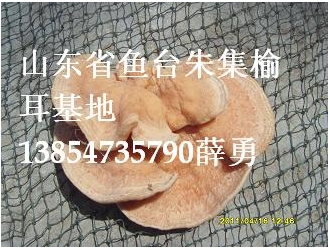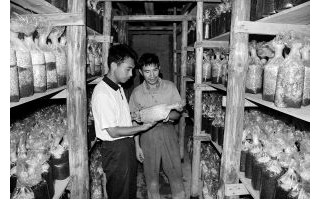MOLECULAR TAXONOMIC RELATIONSHIPS OF AURICULARIA SPECIES INFERRED FROM RAPD MARKERS
Abstract:Molecular taxonomic relationships of the genus Auricularia, together with outgroup of Tremella, were studied using random amplified polymorphic DNA. Eight species of Auricularia and two species of Tremella were examined. The dendrogram derived from RAPD data by UPGMA suggested that the genera Auricularia and Tremella would be monophyletic. For Auricularia, three distinct genetic groups were recognized: the first included A. Peltata and A. Cornea; the second included all strains of A.auricula; the third included five morphological species of A. Delicata, A. Fuscosuccinea, A. Polytricha, A. Maxima and A. Reticulata. This molecular taxonomy suggests that A.cornea and A. Polytricha would be two different species and not synonymous, and the presence or absence of a medulla in cross-section of the basidiocarps would not indicate whether or not taxa are closely related.
Keywords: Jelly fungi, Molecular taxonomy, Heterobasidiomycetes, Auriculariales
利用RAPD标记构建木耳属种间关系的研究
闫培生 蒋家慧 王东昌 罗信昌 周启
摘 要:利用RAPD标记以银耳属的2个种为外类群研究了木耳属8个种的分子系统发育关系.根据UPGMA 构建的树状图结果表明木耳属(Auricularia)和银耳属(Tremella)分别为单一的分类单元.木耳属的8个种被分成3个明显不同的组,第一组包括盾形木耳(A.peltata Lloyd)和角质木耳(A.cornea Spreng.),第二组包括所有供试的黑木耳(A.auricula Underw.),第三组包括皱木耳(A.delicata Henn.)、琥珀木耳(A.fuscosuccinea Farl.)、毛木耳(A.polytricha Sacc.)、大木耳(A.maxima Y. R. Guo)和网膜木耳(A.reticulata L. J. Li)五个形态种.种间发育关系表明角质木耳和毛木耳应是两个不同的种而非同种异名,子实体横切面中髓层的有无并不表明不同种间亲缘关系的远近.
关键词:胶质真菌,分子系统学, 异隔担子菌,木耳目
分类号:Q939.96 文献标识码:A
文章编号:1007-3515(2002)01-0047-0052
基金项目:Supported by the National Natural Science Foundation of China(国家自然科学基金资助项目)
作者单位:闫培生(莱阳农学院应用真菌研究室,山东莱阳,265200)
蒋家慧(莱阳农学院应用真菌研究室,山东莱阳,265200)
王东昌(莱阳农学院应用真菌研究室,山东莱阳,265200)
罗信昌(华中农业大学农业部农业微生物重点实验室,武汉430070)
周启(华中农业大学农业部农业微生物重点实验室,武汉430070)
参考文献:
[1]Barrett M F, 1910. Three common species of Auricularia. Mycologia, 2: 12~18
[2]Berres M E, Szabo J, McLaughlin J, 1995. Phylogenetic relationships in auriculariaceous basidiomycetes based on 25S ribosomal DNA sequences. Mycologia, 87: 821~840
[3]Bidochka M J, McDonald M A, St-Leger R J, et al, 1994. Differentiation of species and strains of entomopathogenic fungi by random amplification of polymorphic DNA. Current Genetic,s 25: 107~ 113
[4]Boidin J, 1986. Intercompatibility and the species concept in the saprobic basidiomycotina. Mycotaxon, 26: 28~ 35
[5]Cheng S, Tu C C, 1978. Auricularia sp. The Biology and Cultivation of Edible Mushroom (ed.S.T.Chang, W.A.Hayes), 605~625 Academic Press: New York
[6]Guo Y R, Liu F C, Wang Y R, 1989. Biological characteristic of Auricularia maxima. Edible fungi, 5: 13~14. (In Chinese)
[7]Hibbett D S, Vilgalys R, 1991. Evolutionary relationships of Lentinus to the Polyporaceae: Evidence from restriction analysis of enzymatically amplified ribosomal DNA. Mycologia, 83: 425~439
[8]Hung C, 1983. A study on the morphology and inner structure of three Auricularia species cultivated in Taiwan. Taiwan Mushroom, 7: 1~13
[9]Kobayasi Y, 1942. On the genus Auricularia from eastern Asia. Bull Centr Natl Mus Manchoukuo, 4: 19~35
[10]Kobayasi Y, 1981. The genus Auricularia. Bull Natl Sci Mus B (Bot), 7: 41~6
[11]Li L J, 1984. Two new species of the genus Auricularia. Acta Mycologica Sinica, 4 (3): 149~154. (In Chinese.) )
[12]Lou L H, Zhu H Z, Tang H G, 1992. Preliminary study on the species of Auricularia. Journal of Edible fungi of China, 11(4):30~32.(In Chinese)
[13]Lowy B, 1951. A morphological basis for classifying the species of Auricularia. Mycologia, 43: 351~358
[14]Nicholson M, Bunyard B A, Royse D J, 1997. Phylogeny of the genus Lentinula based on ribosomal DNA restriction fragment Length polymorphism analysis. Mycologia, 89: 400~407
[15]Raper C A, Raper J R, Miller R E, 1972. Genetic analysis of the lifecycle of Agaricus bisporus. Mycologia, 74: 1088~1117
[16]Rohlf F J,1990. NTSYS-PC: numerical taxonomy and multivariate analysis system. Exeter Publishing: New York, U.S.A.
[17]Sambrook J, Fritsch E F, Maniatis T, 1989. Molecular cloning-A laboratory Manual.2nd ed. Cold spring Harbor Laboratory: Cold Spring Harbor, U.S.A.
[18]Wells K, 1994. Jelly fungi, then and now. Mycologia, 86: 18~48.
[19]Wong G J, Wells K, 1987. Comparative morphology, compatibility and interfertility of Auricularia cornea, A. polytrica and A.tenuis. Mycologia, 79: 847~856
[20]Wu Q X, 1992. Mating tests and systematics in higher basidiomycetes. Acta Mycologica Sinica, 11: 249~ 257. (In Chinese.)
[21]Yan P S, Luo X C and Zhou Q, 2000. Classification and identification of species and strains in Auricularia by using RAPD. Mycosystema, 19(1): 29~33. (In Chinese)
[22]Zhou Y L, Lu G Z, Liu W C, 1998. Systematic studies on Sphaeropsidales by using PCR-RFLP and RAPD analysis. Mycosystema, 17(2): 160~166.(In Chinese.)







